Descubren templo neolítico en el norte de Siria
DAMASCO SEPT. 30, 2006 (AP).- Un equipo de arqueólogos sirios y franceses descubrió un templo de la era neolítica en el norte de Siria que podría ser el más antiguo en Medio Oriente, indicó el sábado la agencia oficial de noticias.
El descubrimiento del templo, construido en el IX milenio antes de Cristo durante la era neolítica, fue hecho por un equipo binacional en Jadet al-Magara, en el río Eufrates, 450 kilómetros al norte de Damasco, dijo la agencia. No indicó cuándo fue desenterrado el recinto.
Una serie de objetos de piedra y hueso fueron encontrados en el vasto templo, cuyos muros presentan diseños geométricos y el dibujo de la cabeza de un toro en vivos tonos rojos, negros y blancos, lo cual presenta una evidencia más del culto al toro en esa época, dijo el informe.
La agencia citó al ministro de Cultura de Siria, Riyad Neisan Agha, quien indicó que este es un descubrimiento único que podría llevar a reinterpretar la cultura.
Fuente: AP / Vanguardia.com.mx, 30 de septiembre de 2006
Enlace: http://srv2.vanguardia.com.mx/hub.cfm/FuseAction
.Detalle/Nota.569217/SecID.23/index.sal
(2) Neolithic temple discovered in northern Syria
DAMASCUS, Syria A team of Syrian and French archaeologists has discovered a Neolithic temple in northern Syria that could be the oldest in the Middle East, Syrias official news agency reported Saturday.
The discovery of the temple, dating to the ninth millennium B.C. during the Neolithic Age, was made by a joint Syrian-French archaeological team at Jaadet al-Maghara on the Euphrates river some 450 kilometers (270 miles) north of Damascus, the agency said. It did not say when the temple was unearthed.
Objects made of stone and bone instruments were found in the large temple, whose walls bore geometric designs and a drawing of a bulls head in vivid red, black and white colors further evidence that bulls where worshipped in that period, the report said.
The agency quoted Syrias minister of culture, Riyad Neisan Agha, as saying that "this is a unique discovery that could lead to re-reading culture."
Fuente: The Associated Press / The International Herald Tribune, 30 de septiembre de 2006
Enlace: http://www.iht.com/articles/ap/2006/
09/30/africa/ME_GEN_Syria_Temple.php
(1) Syrian workers clean the area around the bucrania (bull head), discovered at Al Djada, East Aleppo city, northern Syria October 2, 2006. After fifteen years of excavations on the bank of Euphrates rives, under the direction of Eric Coqueugniot, the French archaeological mission at Djada found some walls which bore symbols of a bull head and are decorated with polychrome geometric paintings. REUTERS/Khaled al-Hariri (SYRIA)
(2) A French archaeology student shows a female figurine discovered at Al Djada, East Aleppo city, northern Syria October 2, 2006. After fifteen years of excavations on the bank of Euphrates rives, under direction of Eric Coqueugniot, the French archaeological mission at Djada found some walls which bore symbols of a bull head and are decorated with polychrome geometric paintings. REUTERS/Khaled al-Hariri (SYRIA)
(3) Eric Coqueugniot, leader of the French archaelogical mission, looks at the area around the bucrania (bull head), discovered at Al Djada, East Aleppo city, northern Syria October 2, 2006. After fifteen years of excavations on the bank of Euphrates rives, under direction of Eric Coqueugniot, the French archaeological mission at Djada found some walls which bore symbols of a bull head and are decorated with polychrome geometric paintings. REUTERS/Khaled al-Hariri (SYRIA)
(4) Eric Coqueugniot, leader of the French archaelogical mission, shows flint tools which were discovered during the excavation of the bucrania (bull head) at Al Djada, East Aleppo city, northern Syria October 2, 2006. After fifteen years of excavations on the bank of Euphrates rives, under direction of Coqueugniot, the French archaeological mission at Djada found some walls which bore symbols of a bull head and are decorated with polychrome geometric paintings. REUTERS/Khaled al-Hariri (SYRIA)
(5) Djadé: restauratrices consolidant les peintures de la première moitié du 9ème millénaire av. J.-C. (© Eric Coqueugniot)
Éric COQUEUGNIOT
Chargé de recherche (CR1), CNRS
Archéologue, lithicien.
Directeur de la revue Paléorient, revue propre du CNRS
Directeur de la fouille de Djadé (Syrie)
Membre du Conseil de Laboratoire dArchéorient
Thèmes de recherche:
* Lhomme et lindustrie lithique du XIIe au IIe millénaire au Levant Nord : Contribution à la compréhension des mutations technologiques et économiques.
* Le PPNB ancien et la Néolithisation du Moyen Euphrate : le cas de Djade,
Travaux en cours:
* Fouille et étude du village de Djadé (seconde moitié du IXe millénaire av. J.-C., Moyen Euphrate, Syrie)
* Étude des industries lithiques du Ve au IIe millénaire av. J.-C.: Abu Hamid (Jordanie), Güvercinkayasi (Turquie), Mari (Syrie), prospection Marges Arides (Syrie), tell Arqa (Liban), Malia (Crète)...
Enseignement:
Université Lumière-Lyon 2
* Séminaires de master ("Actualités Préhistoriques")
* Tutorat de la thèse de Makoto ARIMURA (étudiant japonais, Lyon 2)
Principales publications:
CAUVIN M.-C., COQUEUGNIOT É. (avec la collaboration de CHATAIGNER C. et de Le TENSORER J.-M.), 1989, Techniques déchantillonnage et analyse spatiale. Le campement épipaléolithique de Nadaouiyeh 2 (el Kowm, Syrie), Oxford, BAR Int. Ser. 522, 168 p.
COQUEUGNIOT É., 1991, "Outillage de pierre taillée au Bronze Récent. Ras Shamra 1978- 1988", In M. Yon (sous la dir. de), Ras Shamra-Ougarit VI : Arts et Industries de la pierre, Paris, ERC, p. 127-204.
COQUEUGNIOT É., 1993, "Un atelier spécialisé dans le Palais de Mari. Outils de pierre taillée et travail de la nacre à la fin de lEarly Dynastic", Paris, ERC , M.A.R.I., 7, p. 205-250.
COQUEUGNIOT É., 1994, "Lindustrie lithique de Djade el Mughara et le début du P.P.N.B. sur lEuphrate syrien (sondages 1991 et 1992)", in H.-G. Gebel, S.K. Koszlowski (éds.), Neolithic Chipped Stone Industries of the Fertile Crescent. Proceedings of the First Workshop on PPN Chipped Lithic Industries, Berlin 1993 , Berlin, Early Near Eastern Production, Subsistence, and Environment, 1, p. 313-330.
CHATAIGNER C., COQUEUGNIOT É., 1995, "Classifications comparées par statistiques élémentaires et méthodes automatiques - Application à des lames et lamelles de lEpipaléolithique du Levant" (Actes du Colloque Européen Archéologie et Informatique., Saint-Germain-en-Laye, France, 21, 22, 23 et 24 Novembre 1991). L. Valdés, I. Arenal, I. Pujana (eds), Aplicaciones informaticas en Arqueologia : Teoria y Sistemas, Bilbao : Denboraren Argia, p. 142-155.
COQUEUGNIOT É., 1998, "Djade el Mughara (Moyen-Euphrate), un village néolithique dans son environnement naturel à la veille de la domestication", in M. Fortin et O. Aurenche (eds), Espace naturel, espace habité en Syrie du Nord (10è-2è millénaires av. J.-C.), Toronto, Lyon : Canadian Society for Mesopotamian Studies (Bull. 33), Maison de lOrient Méditerranéen (TMO 28), p. 109-114.
COQUEUGNIOT É., JAMIESON A. S., MONTERO FENOLLOS J.-L. et ANFRUNS J . , 1998, "Une tombe du Bronze ancien à Djade el Mughara (Moyen Euphrate, Syrie)", Cahiers de lEuphrate 8, p. 85-114.
COQUEUGNIOT É., 1998, "Lobsidienne en Méditerranée orientale aux époques post-néolithiques", in M.C. Cauvin et al. ( éds) Lobsidienne au Proche-Orient : du volcan à loutil, Oxford-Lyon, BAR-Tempus Reparatum, p. 351-362.
COQUEUGNIOT É. 1999, "Tell Djade el Mughara", in G. del OLMO LETE, J.-L. MONTERO FENOLLOS éd., Archaeology of the Upper Syrian Euphrates. The Tishrim Dam Area, Proceedings if the International Symposium Barcelona, 1998, p. 41-55.
COQUEUGNIOT É. 2000, "Djade (Syrie), un village à la veille de la domestication (seconde moitié du 9e millénaire av. J.C.)", in J. Guilaine, Les premiers paysans du monde, naissance des agricultures (séminaire du Collège de France), Paris, Errance, p. 63-79.
COQUEUGNIOT É. (avec une contribution de CHATAIGNER C.), 2003, "Les outils de pierre taillée de Larsa 1989 (IIIe et IIe millénaires av. J.-C.)", in J.-L. Huot (dir.), Larsa- Travaux de 1987 et 1989, Beyrouth, IFAPO (BAH 165), p. 385-412.
COQUEUGNIOT É., 2003, "Unité et diversité des industries lithiques taillées au Proche-Orient (Levant et Anatolie méridionale) du IXe au VIIe millénaire av. J.-C.", in A.Le Brun et J. Guilaine (éd.), Le Néolithique de Chypre, Athènes, EFA (BCH Suppl. 43), p. 373-387.
COQUEUGNIOT É., 2003, "Figurines et représentations animales dans les villages néolithiques du Proche-Orient", in B. Gratien, A. Müller et D. Parayre (éd.), Figurines animales dans les mondes anciens (Journée détude de Lille, 8 juin 2002). Anthropozoologica 38, p. 35-48.
COQUEUGNIOT É., 2004, "Les industries lithiques du Néolithique ancien entre Moyen Euphrate et Jezireh orientale Réflexions sur deux voies évolutives", in O. Aurenche, M. Le Miere and P. Sanlaville (eds), From the River to the Sea- The Paleolithic and the Neolithic on the Euphrates and in the North Levant, Studies in honour of Lorraine Copeland , Oxford et Lyon, BAR-Maison de lOrient méditerranéen (BAR Int. Ser. 1263), p. 295-308.
(6) Djade PPNB ancien - Figurine féminine façonnée dans la masse dun os de grand module et vues de face et de profil dune figurine feminine façonnée en transformant de manière minimale une phalange déquidé.
(7) Djade PPNB ancien - Bucrane daurochs (Bos primigenius) femelle. Ce bucrane a été découvert en 1999 enterré sous un banquette, à lintérieur dune maison du village néolithique (secteur C) en position retournée, comme le montre la vue in situ.
(8) Djade PPNB ancien - Galet gravé dun décor en chevrons.
(9) Vue du site de Djadde el Mughara en cours de fouille.
Descubierto en Siria un edificio que data del año 9.000 a.C
DAMASCO (AFP) - Un edificio decorado con pinturas polícromas que data aproximadamente del año 9.000 a.C acaba de ser descubierto en la orilla del Eufrates, en el norte de Siria, anunció el martes en Damasco el responsable de la misión arqueológica francesa en Siria, Eric Coqueugniot.
"Acaba de realizarse un descubrimiento excepcional (...) de un gran edificio circular que data más o menos del 8.800 a.C, en Dja'de (orilla izquierda del Eufrates)", precisó Coqueugniot a la AFP.
El edificio, mucho más grande que las viviendas habituales, "debía de tener un uso colectivo, probablemente para todo el pueblo o para un grupo", añadió el responsable.
"Una parte de este edificio comunitario tiene la forma de un cráneo de buey y conserva una decoración a base de pinturas, la más antigua que se conoce en Oriente Medio", añadió el investigador francés.
"Las pinturas geométricas polícromas" que decoran el edificio serán exhibidas más tarde en el museo de Alepo, en el norte de Siria, añadió.
"Numerosas armas de caza (puntas de flecha) y herramientas domésticas, la mayoría de ellas de sílex, también han sido descubiertas" en el lugar, agregó.
Fuente: AFP, 4 de octubre de 2006
Enlace: http://es.news.yahoo.com/04102006/159/
descubierto-siria-edificio-data-ano-9-000-c.html
(2) Archaeologists find 8800BC buildingFrom correspondents in Damascus, Syria
Archaeologists said they have discovered an 11-millennium-old building with on the banks of the Euphrates River in northern Syria.
A remarkable discovery has just been uncovered of a large circular building dating back to 8800BC near (the locality of) Ja'de, said the head of the French archaeological team that made the find.
The building, much larger than normal houses, had a collective use, probably for all of the village or a group, Eric Coqueugniot said.
A part of this community building takes the shape of the head of a bull and retains painted decorations, the oldest known in the Middle East, he said.
The multi-coloured geometrical paintings that decorate the building would be displayed at the museum of Aleppo, in northern Syria.
Many hunting weapons, domestic tools were discovered at this level. The majority of these tools are made of flint and very few are of obsidian (volcanic stone), he said.
Mr Coqueugniot heads the team of the National Centre for Scientific Research (CNRS), France's largest scientific establishment, which has led the excavation work at the site for the past 15 years.
Fuente: Agence France-Presse
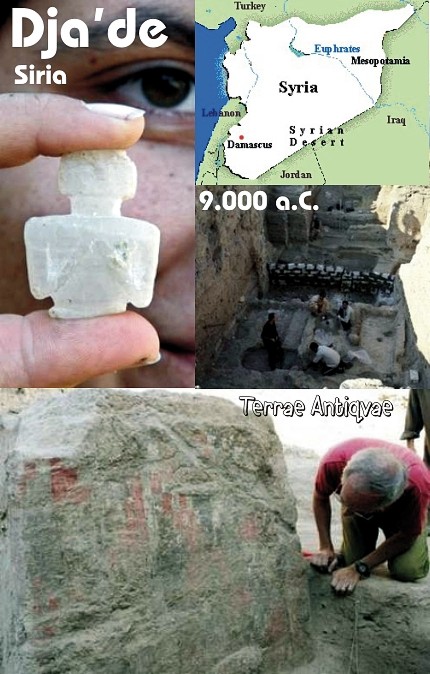
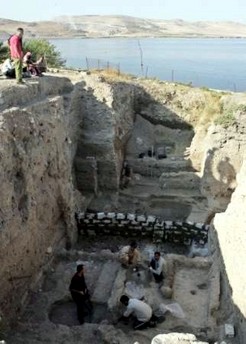
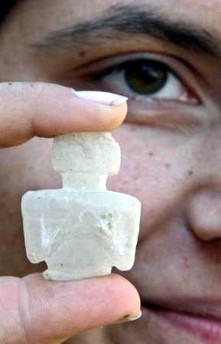

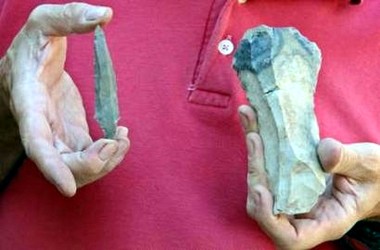
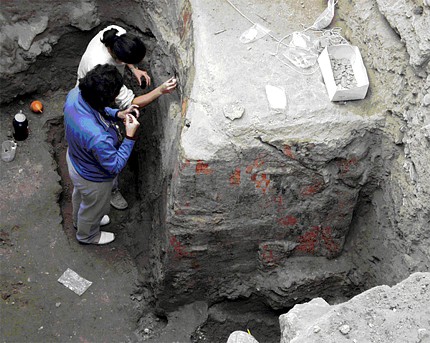
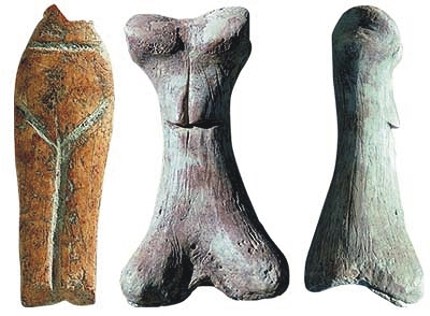
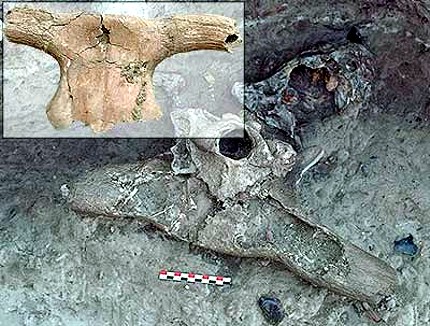
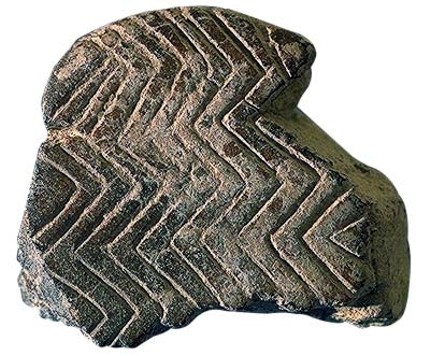
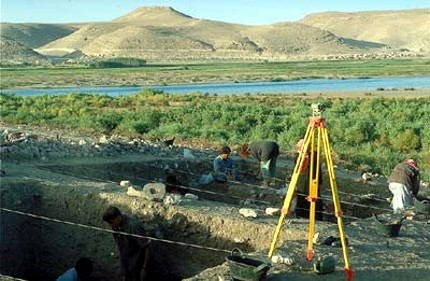
0 comentarios